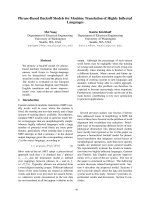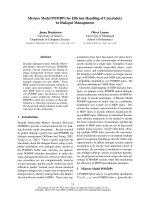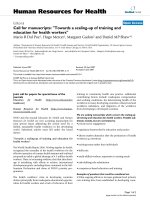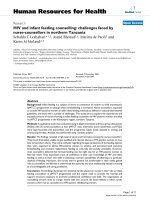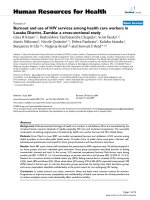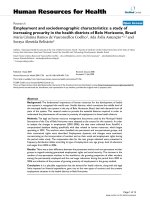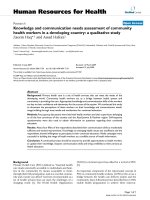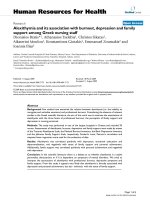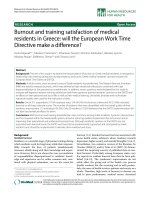Báo cáo sinh học: " Hepatoprotection and neuroprotection induced by low doses of IGF-II in aging rats" doc
Bạn đang xem bản rút gọn của tài liệu. Xem và tải ngay bản đầy đủ của tài liệu tại đây (446.01 KB, 9 trang )
RESEARC H Open Access
Hepatoprotection and neuroprotection induced
by low doses of IGF-II in aging rats
Inma Castilla-Cortázar
1*
, María García-Fernández
2
, Gloria Delgado
2
, Juan E Puche
1
, Inma Sierra
1
, Rima Barhoum
1
and Salvador González-Barón
2
Abstract
Background: GH and IGFs serum levels decline with age. Age-related changes appear to be associated to
decreases in these anabolic hormones. We have previously demonstrated that IGF-I replacement therapy improves
insulin resistance, lipid metabolism and reduces oxidative damage (in brain and liver) in aging rats. Using the same
experimental model, the aim of this work was to study whether the exogenous administration of IGF-II, at low
doses, acts analogous to IGF-I in aging rats.
Methods: Three experimental groups were included in this study: young healthy controls (yCO, 17 weeks old);
untreated old rats (O, 103 weeks old); and aging rats treated with IGF-II (O+IGF-II, 2 μg * 100 g body weight
-1
*
day
-1
) for 30 days. Analytical parameters were determined in serum by routine laboratory methods using an
autoanalyzer (Cobas Mira; Roche Diagnostic System, Basel, Switzerland). Serum levels of hormones (testo sterone,
IGF-I and insulin) were assessed by RIA. Serum Total Antioxidant Status was evaluated using a colorimetric assay.
Mitochondrial membrane potential was evaluated using rhodamine 123 dye (adding different substrates to
determine the different states). ATP synthesis in isolated mitochondria was determined by an enzymatic method.
Results: Compared with young controls, untreated old rats showed a reduction of IGF-I and testosterone levels
with a decrease of serum total antioxidant status (TAS). IGF-II therapy improved serum antioxidant capability
without modifying testosterone and IGF-I circulating concentrations. In addition, IGF-II treatment reduced oxidative
damage in brain and liver, improving antioxidant enzyme activities and mitochondrial function. IGF-II was also able
to reduce cholesterol and triglycerides levels increasing free fatty acids concentrations.
Conclusions: We demonstrate that low doses of IGF-II induce hepatoprotective, neuroprotective and metabolic
effects, improving mitochondrial function, without affecting testosterone and IGF-I levels.
Background
The Insulin-like Growth Factors (IGF-I and IGF-II) are
ubiquitously expressed growth factors that have pro-
found effects on the growth and differentiation of many
cell types and tissues, including cells from the CNS
[1-3].
We have previously studied some condition s of “IGF-I
deficiency”, such a s liver cirrhosis and aging, in which
replacement therap y coul d be considered as an effective
therapeutic strategy [ 4-16]. In fact, the exogenous
administration of low doses of IGF-I in aging rats was
able to reduce oxidative damage (in brain and liver)
improving mitochondrial functio n and antioxidant
enzyme activities; and to diminish insulin resistance and
improve lipid metabolism [4,5] . These benef icial effects
were associated to an increase in testosterone levels.
IGF-II is a peptidic h ormone of 67 amino acids that
belongs to the family of IGFs. It plays an important role
in the embryology development but the physiological
functions of IGF-II in the adult life are not fully under-
stood [17,18].
GH, IGF-I and IGF-II concentrations decline with age.
Age-related changes appear to be link ed to decreases in
these anabolic hormones. A significant amount of evi-
dence has been accumulated showing that IGF-I might
play a role in several pathological conditions usually
* Correspondence:
1
Department of Medical Physiology, CEU-San Pablo University School of
Medicine Institute of Applied Molecular Medicine (IMMA) Boadilla del Monte,
28668 Madrid, Spain
Full list of author information is available at the end of the article
Castilla-Cortázar et al. Journal of Translational Medicine 2011, 9:103
/>© 2011 Castilla-Cortázar et al; licensee BioMed Central Ltd. This is an Open Access article distribu ted under the terms of the Creative
Commons Attribution License ( which permits unrestricted use, distribution, and
reproduction in any medium, provided the original work is properly cited.
observed during aging associated with oxidative damage
[3,19-21].
The aim of this work was to investigate whether IGF-
II is able to act analogous to IGF-I in aging. Accord-
ingly, this study was designed to examine the effect of
low doses of IGF-II in old rats on: anabolic hormones
(testosterone, insulin and IGF-I); glucose and lipid meta-
bolisms; total antioxidant status (TAS, as the reductive
capability of serum depending on enzyme and non-
enzyme molecules) [22]; and on oxidative damage in
brain (cortex and hippocampus) and liver.
A similar design was performed [4] using the same
markers of lipid peroxidation (Malondialdehyde, MDA)
and protein carbonylation (Protein Carbonyl Content,
PCC) as well as the parameters of mitochondrial func-
tion (mitochondrial membrane potential-MMP- and
ATP synthesis). Three experimental groups were
included in that protocol: young healthy controls (yCO,
17 weeks old); untreated old rats (O, 103 weeks old);
and aging rats treated with IGF- I (O+IGF-I) for 30 days
(2.25 μg 100 g body weight
-1
day
-1
).
Methods
Experimental design
The age of the control animals was selected following
the criteria previo usly descr ibed in Garcia-Fernandez M
et al. [4]. Thus, 17 weeks old (wk) mice were judged to
be a suitable age for young controls (yCO). 103 wk mice
were considered suitable to evaluate the decline i n ana-
bolic hormones and the reduction in antioxidan t cap-
ability, as well as to investigate the impact of IGF-II
therapy on these parameters in aging animals. The
experimental procedure was performed as follow:
healthy male Wistar rats were divided into two groups
according to age: yCO (n = 8) 17 wk, and aging control
rats 103 wk. Old animals were randomly assigned to
receive either 0.5 mL saline (group O, n = 8) or 2 μg
rhIGF-II 100 g bw
-1
d
-1
(Lilly Laboratories, Madrid,
Spain) subcutaneously (group O+IGF-II, n = 8) for 30
days. This IGF-II dose was elected by maintaining a
similar one used in previous studies with IGF-I (i n
order to be able to compare their relative actions).
All experimental procedures were performed in com-
pliance with The Guiding Principles for Research Invol-
ving Animals [23] and approved by the Bioethical
Committee from t he University of Málaga. Both food
(standard semipurified diet for rodents; B.K. Universal,
Sant Vicent del Horts, Spain) and water were given ad
libitum. Rats were housed in cages placed in a room
with a 12-h light, 12-h dark cycle and constant humidity
and temperature (20°C).
In the morning o f the 31st day, blood was obtained
from the retroocular plexus with capillary tubes (70
mm; Laboroptik, Marienfeld, Germany) and divided into
aliquots that were stored at -20°C until used. The ani-
mals were then killed by decapitation. The liver and
brain were dissected. Samples from the cortex and hip-
pocampus were stored separately until assaying at -8 0°C
after immersion in liquid Nitrogen.
In six animals from each group, a part of the fresh
liver was used to isolate mitochondria and to perform
mitochondrial function tests by flow cytometry.
Analytical methods in serum
Analytical parameters (total protein, glucose, cholesterol,
triglycerides, free fatty acids, aspartate transaminase and
alanine transaminase) were determined in serum by rou-
tine laboratory methods using an autoanalyzer (Cobas
Mira; Roche Diagnostic System, Basel, Switzerland).
Serum levels of hormones (testosterone, IGF-I and
insulin) were assessed by RIA in a GammaChen 9612
Plus (Serono Diagnostics, Roma, Italy) using specific
commercial assay systems: a) free testosterone by a
Coat-a-Count, DPC (Diagnost ic Products Corp., Los
Angeles, CA). The sensitivity of total testosterone assay
was 4 ng/dL, and the intraassay coefficient of variation
waslessthan7%;b)assessmentofserumIGF-Ilevels
were performed using radioimmunoassay with coated
tubes for the determination of IGF-I (IGF binding pro-
tein blocked), which included elimination of interference
by IGF binding protein through excess IGF-I as well as
acid alcohol (ALPCO Diagnostics, Windham, NH). The
sensitivity of IGF-I assay was 0.1 ng/mL and the inter-
serial coefficient of variation was 7.4; c) Insulin levels
were determined using a specific kit for RIA (LINCO
Research, Inc., St. Charles, MO) following protocol
instructions. The sensitivity was 0.1 ng/mL.
The homeostasis model assessment (HOMA), as an
index of insulin resistance, was assessed using the
HOMA Calculator Program version 2.0 based on the
HOMA formula [24,25]. The HOMA estimates steady
state b-cell function (percent B) and insulin S (percent
S) as percentages of a norm al reference population.
These measures correspond well but are not necessarily
equivalent to non steady state estimates of b-cell func-
tion and insulin S derived from stimulatory models such
as the hyperinsulinemic clamp, hyperglycemic clamp, iv
glucose tolerance test (acute insulin response, minimal
model), and the oral glucose tolerance test (0-30 δ insu-
lin/glucose ratio).
Serum Total Antioxidant Status [26], as total enzy-
matic and non enzymatic antioxidant capability of
serum, was evaluated using a colorimetric assay (Randox
Laboratories Ltd., CrumLin, UK) using the following
principle: Abts [2,2´-Azino-di-(’3-ethylbenzthiazoline
sulfonate)] was incubated with a peroxidase (metmyo-
globin) and H
2
O
2
to produce the radical cation Abts
+
.
This has a relatively stable blue-green color, which is
Castilla-Cortázar et al. Journal of Translational Medicine 2011, 9:103
/>Page 2 of 9
measured at 600 nm. Antioxidants in the added sample
cause suppression of this color production to a degree
that is proportional to their concentration [22].
Parameters of oxidative damage and antioxidant
defenses in liver and brain homogenates
Lipid peroxidation
Malondianldehyde (MDA) was used as an index of lipid
peroxidation [27] in liver and brain homogenates, and it
was measu red after heating sam ples at 45°C for 60 min.
in acid medium. It was quantified by a colorimetric
assay using LPO-586 (Bioxytech; OXIS International
Inc., Portland, OR), which after reacting with MDA gen-
erates a stable chromophore that can be measured at
586 nm (Hitachi U2000 Spectro; Roche Molecular Bio-
chemicals, Basel, Switzerland) [26,27].
Protein Carbonyl Content (PCC)
PCC was determined by the method of Levine et al.
[28]. Each sample was divided into two por tions con-
taining 1 to 2 mg protein each. An equal volume of 2 M
HCl was added to one portion, incubated at room tem-
perature for 1 h, and shaken intermittently. The other
portion was treated with an equal volume of 10 mM
dinitrophenylhydrazine in 2 M HCl and incubated for 1
h. at room temperature. After incubation, the mixture
was precipitated with 10% trichloroacetic acid and
centrifuged.
The precipitate was washed with ethanol-ethyl acetate
(1:1), twice dissolved in 1 mL 6 M guanidine HCl, cen-
trifuged at low speed, and the supernatant was
extracted. The difference in absorbance between the
dinit rophenylhydrazine-treated and HCl-treated samples
was determined at 366 nm.
Antioxidant Enzyme Activities
Superoxide dismutase (SOD) [Enzyme Commission of
the International Union of Biochemistry (EC) 1. 15. 1.
1.], catalase (EC 1. 11. 1. 6.) and glutathione peroxidase
(GPX: E C 1. 11. 1. 9.) activities were measured both in
brain and liver tissues. Samples were homogenized in
Tris-HCl buffer [20 mmol/L (pH 7.4); 1 g tissue/10 mL]
at 0°C and centrifuged at 25,000 g for 30 min at 4°C. All
measurements were performed in the supernatant. SOD
activity was determined at 37°C using a commercial kit
(Randox Laboratories) and an autoanalyzer (Cobas Mira;
Roche Diagnostic System, Basel, Switzerland). Catalase
activity was d etermined at 25°C by measuring the
changes of absorbance using final concentrations of 10
mmol/L H
2
O
2
and 50 mmol/L phosphate buffer (pH
7.0) at 240 nm during the time interval 15-30 sec after
addition of the sample [26,29,30]. GPX was measured at
37°C with the Ransod commercial kit using the Cobas
Mira autoanalyzer, and its activity was expressed in
units (1 U equals to 1 μmol substrate turnover/min) per
milligram of protein [30].
GRD (EC 1. 6. 4. 2.) was measured in brain homoge-
nates. Antioxidant activity was determined at 37°C using
a commercial kit (Ransod; Randox Laboratories) and the
same autoanalyzer as above.
Isolation of liver mitochondria
Liver mitochondrial fraction was prepared according to
the method described by Hogeboom and Schneider [31]
with modifications. Liver samples were homogenized (1:10
wt/vol) in an ice-cold isolation buffer (pH 7.4) containing
sucrose 0.25 M, KH
2
PO
4
5 mM, 3[N-morholino]propane-
sulfonic acid 5 mM, and 0.1% BSA. The homogenate was
centrifuged at 800 × g for 10 min. The resulting superna-
tant was centrifuged at 8,500 × g for 10 min. The superna-
tant was discarded, and the pellet diluted in cold isolation
buffer and centrifuged at 8,500 × g for 10 min. three times.
The final mitochondria pellet was resuspended in a mini-
mal volume, and aliquots were stored at -80°C until used
in enzyme assays. All procedures were conducted at 4°C.
Flow cytometry analysis in isolated mitochondria
Mitochondrial Membrane Potential (MMP)
MMP was evaluated using rhoda mine 123 dye (RH123)
obtained from Molecula r Probes, Inc. (Eugene, OR). It
has an absorbance maximum of 500 nm and an emis-
sion maximum o f 523 nm. Mitochondrial suspensions
(40 to 50 μg protein mitochondria/mL) were incubated
in isolation buffer for 5 min. in the dark with RH123
(0.5 μg/mL), after adding various agents. For state 4
conditions, the mitochondrial samples were incubated
with rotenone 25 μM and energized with sodium succi-
nate 5 mM, and with rotenone 25 μM, sodium succinate
5mMplusADP200μM for state 3 conditions. T he
uncoupler valinomycin 10 μMwasaddedtoconfirm
that the uptake of RH123 was related to MMP [32].
Finally, 2.5 μg /mL oligomycin (Sigma-Aldrich, St. Louis,
MO) was added as an inhibitor of ATP synthetase to
block all phosphorylation-related respiration [32].
ATP synthesis by mitochondria
ATP synthesis was assessed [33] by resuspending a
mitochondrial population in buffer and supplemented
with 5 mM KH
2
PO
4
, 5 mM succinate, and 5 mM ADP,
and then incubated for 15 min at 37°C. The reaction
was stopped by adding an equal volume of 12% trichlor-
oacetic acid, and the reaction mixture was centrifuged
at 1,200 g for 15 min. at 4°C. The supernatant was neu-
tralized with 6 N KOH and measured for ATP by an
enzymatic method using a kit obtained from Sigma Che-
mical (Tokyo, Japan).
Statistical analysis
Data are expressed as mean ± SEM. To assess the
homogeneity among the different groups of rats, a
Castilla-Cortázar et al. Journal of Translational Medicine 2011, 9:103
/>Page 3 of 9
Kruskal-Wallis test was used, followed by multiple post
hoc comparisons using Mann-Whitney U tests. A
regression model was fitted considering SOD and MDA
as the independent and dependent variables, respec-
tively. Any P value less than 0.05 was considered statisti-
cally significant.
Calculations were performed with SPSS in v.15.0 pro-
gram (SPSS, Inc., Chicago, IL).
Results
The experimental model of aging was previously charac-
terized [4] attending to the evolution of serum levels of
IGF-I, free testosterone and total antioxidant status.
Effect of IGF-II therapy on anabolic hormones and serum
total antioxidant status
Consistent with previous studies [4], old anima ls showed
a reduction in IGF-I and testosterone levels and a statisti-
cally significant increase of insulin levels (see Table 1). In
contrastwithIGF-Itherapy,IGF-IItreatmentwasnot
able to increase testosterone circulating levels and
slightly reduced insulin levels. No changes were observed
in IGF-I circulating concentrations (see Table 1).
However, IGF-II treatment significantly increased
serum total antioxidant capability (TAS), reaching simi-
lar values to those reported with the IGF-I replacement
therapy [4].
Effect of IGF-II therapy on glucose and lipid metabolisms
Of interest, untreated aging rats (O group) showed an
increase of cholesterol and triglycerides circulating levels
that IGF-II therapy reduced by increasing free fatty
acids (Figure 1). These effects on lipid metabolism were
similar to those found previously with IGF-I replace-
ment therapy [4].
Table 2 summarizes the analytical parameters in the
three experimental groups. IGF-II therapy was not able
to reduce neither blood glucose levels (in contrast with
IGF-I treatment [4]) nor total protein (as previously
shown by IGF-I treatment [4]). However, it was only
found a slight effect on insulin resistance (HOMA
index).
Oxidative damage and antioxidant enzyme activities in
brain and liver, in the three experimental groups
Parameters of oxidative damage in brain (cortex and
hippocampus) in the three experimental groups are
shown in Figure 2. Untreated old rats (O) presented sig-
nificant i ncreases of lipid peroxidation products (MDA,
Table 1 Circulating levels of testosterone, IGF-I and insulin in the three experimental groups
Young controls (yCO)
(n = 8)
Untreated old rats (O)
(n = 8)
Old rats treated with IGF-II (O+IGF-II) (n = 8)
Free testosterone (pg/mL) 6.50 ± 1.16 4.01 ± 0.76
a
4.07 ± 1.34
a
IGF-I (ng/mL) 978.92 ± 63.66 629.12 ± 16.56
a
656.00 ± 25.57
a
Insulin (ng/mL) 0.45 ± 0.08 1.54 ± 0.43
a
1.12 ± 0.10
Total Antioxidant Status (mmol/L) 0.87 ± 0.01 0.79 ± 0.01
a
0.87 ± 0.02
b
Effect of IGF-II treatment on serum total antioxidant status.
Values are expressed as ± SEM.
a
P < 0.05 vs yCO
b
P < 0.05 vs O
Figure 1 Effect of IGF-II therapy on lipid metabolism.
Castilla-Cortázar et al. Journal of Translational Medicine 2011, 9:103
/>Page 4 of 9
expressed as nmo l/mg protein; and PCC, expressed as
nmol/mg protein) compared with yCO (cortex MDA: O
= 0.12 ± 0.02 vs. yCO = 0.09 ± 0 .01, P < 0.05; cortex
PCC: O = 20.21 ± 3.91 vs. yCO = 7.90 ± 1.19, P <0.05;
hippocampus MDA: O = 0.95 ± 0.15 vs.yCO=0.57±
0.05, P < 0.05; and hippocampus PCC: O = 20.35 ± 2.94
vs. yCO = 13.11 ± 2.07, P < 0.05).
Low doses of IGF-II were able to reduce significantly
both parameters of oxidative damage (cortex MDA: O
+IGF-II = 0.08 ± 0 .02; cortex PCC: O+IGF-II = 11.13 ±
4.10; hippocampus MDA: O+IGF-II = 0.55 ± 0.09; and
hippocampus PCC: O+IGF-II = 13.56 ± 1.54, nmol/mg
protein), reaching v alues similar to those found in
young controls (P=ns).
Regarding antioxidant enzyme activities, several statisti-
cally significant alterations were found in untreated aging
rats (O group) compared with yCO, which are summar-
ized in Table 3. Old rats treated with IGF-II showed simi-
lar values to those found in yCO (P=ns yCO vs. O+IGF)
with the only exception of GPX in hippocampus (P <
0.05). A close correlation was found between SOD activity
and MDA in hippocampus: Figure 3.
In liver homogenates, MDA was significantly
increased in untreated old rats (O = 0.19 ± 0.02 vs.
yCO = 0.10 ± 0.01; P < 0.001), and IGF-II therapy also
reduced this marker of lipid peroxidation (O+IGF-II =
0.16 ± 0.01, P <0.01vsyCOandP <0.05vsO).Not
statistically significant differences were found in PCC
Table 2 Analytical parameters in the three experimental groups
Young controls (yCO) (n = 8) Untreated old rats (O) (n = 8) Old rats treated with IGF-II (O+IGF-II) (n = 8)
Total Proteins (g/L) 56.33 ± 0.47 63.08 ± 1.23
a
67.83 ± 0.48
a
Glucose (mmol/L) 4.10 ± 0.41 5.49 ± 0.22
b
5.44 ± 0.19
b
HOMA 1.17 ± 0.45 5.95 ± 1.55
c
3.05 ± 0.56
bd
ALT (U/L) 25.93 ± 1.14 26.41 ± 2.47 30.33 ± 2.61
AST (U/L) 99.84 ± 5.60 86.26 ± 5.41 108.33 ± 5.91
Values are expressed as ± SEM. ALT, Alanine transaminase; AST, aspartate transaminase
a
P < 0.001 vs yCO
b
P < 0.05 vs yCO
c
P < 0.01 vs yCO
d
P < 0.05 vs O
Figure 2 Parameters of oxidative damage in brain: protein carbonylation (PCC) and lipid peroxidation ( MDA).(A)Incortex;(B)In
hippocampus.
Castilla-Cortázar et al. Journal of Translational Medicine 2011, 9:103
/>Page 5 of 9
between the three experimental groups (yCO = 3.41 ±
0.82; O = 4.21 ± 1.38; and O+IGF-II = 3.88 ± 1.68
nmol/mg protein; P = ns) in liver. Result s regarding
antioxidant enzymes activities in liver are summarized
in Table 3. Only significant differences between groups
were found in catalase, which was decreased in
untreated old rats (P < 0.05), whereas IGF-II-treated
old rats presented similar values to those found in
yCO. All these data are similar to those found with
IGF-I therapy in aging rats [ 4].
Mitochondrial Membrane Potential (MMP) and ATP
synthesis in liver mitochondria
Figure 4 summarizes the MMP with different sub-
strates, which is considered a good marker of mito-
chondrial function. A reduction of MMP was
observed in untreated aging rats in all conditions
compared with yCO group: state 4 (P < 0.001 vs.
yCO), state 3 (P <0.01vs. yCO), and with oligomycin
( P <0.05vs. yCO), whose deactivating ATPase shows
the condition of maximum intramitochondrial
negativity.
Mitochondria from old rats treated with IGF-II ther-
apy presented similar values to those found in mito-
chondria from yCO group (P=ns) in all conditions
(state 4: yCO = 34.23 ± 4.05, O = 13.25 ± 2.15, P <
0.001; O+IGF-II = 25.67 ± 4.34 P <0.05vsO)(state3:
yCO = 15.95 ± 2.50, O = 8.80 ± 1.10, P < 0.05; O+IGF-
II=15.40±3.60,P=nsvsyCO)(witholigomycin:
yCO = 41.75 ± 4.10, O = 16.35 ± 4.10, P <0.05;O
+IGF-II = 29.89 ± 6.25, P < 0.05 vs O)
Accordingly, ATP production was reduced in
untreated aging rat s (yCO = 0.18 ± 0.01 vs.O=0.13±
0.01 μmol/mg mitochondrial protein), and IGF-II ther-
apy was able to recover ATP production, reaching simi-
lar values to those found in yCO (O+IGF-II = 0.20 ±
0.02 μmol/mg mitochondrial protein): Figure 5.
Discussion
GH/IGFsaxisdeclineswithage.Wehavepreviously
considered that aging is a novel “ condition of IGF-I
deficiency” since circulating levels of this hormone
are reduced, anabolism is diminished and oxidativ e
Table 3 Antioxidant enzymes activities in brain and liver
Young controls (yCO)
(n = 8)
Untreated old rats (O)
(n = 8)
Old rats treated with IGF-II (O+IGF-II)
(n = 8)
In cortex Catalase (U/mg prot) 22.8 ± 0.85 18.90 ± 1.05
a
20.2 ± 1.2
b
SOD (U/mg prot) 3.99 ± 0.09 5.32 ± 0.38
a
4.8 ± 0.2
GPX (mU/mg prot) 89.3 ± 2.85 77.9 ± 2.85
a
108 ± 5
b
GRD (U/mg prot) 41.80 ± 0.09 42.75 ± 1.9 46 ± 2
In hippocampus Catalase (U/mg prot) 9.40 ± 0.47 15.01 ± 2.09
a
7.9 ± 1.1
c
SOD (U/mg prot) 1.23 ± 0.09 1.99 ± 0.19
d
1.3 ± 0.2
c
GPX (mU/mg prot) 55.1 ± 2.85 83.6 ± 4.75
d
66 ± 5
GRD (U/mg prot) 31.35 ± 0.09 42.75 ± 2.85
a
35 ± 4
In liver Catalase (KU/mg) 2.85 ± 0.28 1.90 ± 0.19
b
2.70 ± 0.60
SOD (U/mg) 11.59 ± 1.71 12.25 ± 1.99 18.20 ± 2.00
GPX (U/mg) 1.04 ± 0.09 2.09 ± 0.19
b
2.10 ± 0.10
b
Values are expressed as ± SEM. prot, Protein.
a
P < 0.01 vs yCO
b
P < 0.05 vs yCO
c
P < 0.05 vs O
d
P < 0.001 vs yCO
Figure 3 Direct and significant correlation between the specific
activity of SOD and the marker of lipid peroxidation MDA in
hippocampus.
Castilla-Cortázar et al. Journal of Translational Medicine 2011, 9:103
/>Page 6 of 9
stress is one o f the most important mechanisms of
cellular damage in a ging [4,26]. IGF-II levels are also
reduced in aging [34]. IGF-II is expressed in the brain
and surrounding structures [1]. However, the physio-
logical role of IGF-II in adult life is not fully
understood.
Although there are interesting discrepancies for
understanding the physiological relevance of the reduced
concentrations of GH and IGFs in aging, it is well estab-
lished that IGF-I replace ment therapy induces beneficial
effects including neuroprote ction and hepatoprotection
as well as a reduction of insulin resistance and l ipid cir-
culating levels increasing testosterone [4,5].
In the present study, w e analyzed whether low doses
of IGF-II are able to induce similar effects that those
reported with IGF-I [4,5] acting analogous to IGF-I in
aging rats.
Consistent with previous findings, old rats showed
hyperlipidemia and insulin resistance, increased brain
and hepatic oxidative damage and reduced testosterone
circulating levels, compared with young controls. In
addition, untreated aging rats showed a mitochondrial
dysfunction with depletion of MMP and a significant
reduction of ATP synthesis.
The major finding in this study is the recognition that
the exogenous administration of low dos es of IGF-II is
able to exert beneficial effects on age related changes with-
out increasing testosteron e levels. This occurred through
reducing oxidative damage on brain and liver as shown by
normalization of mitochondrial dysfunction and
Figure 5 ATP synthesis in isolated mitochondria from the three
experimental groups: IGF-II therapy increased ATP production.
Figure 4 Mitochondrial Membrane Potential (MMP) in isolated liver mitochond ria by flow cytometry. MMP is considered a good marker
of mitochondrial function [32] which is assessed under different substrates. Mitochondria from untreated aging rats (O group) showed a
significant depletion of MMP in all conditions. AUF, arbitrary units of fluorescence.
Castilla-Cortázar et al. Journal of Translational Medicine 2011, 9:103
/>Page 7 of 9
antioxidant enzyme activities. Therefore, these results
allow us to clearly discerning that the outlined cytoprotec-
tive effects are owed to specific actions of the IGFs.
In contrast with the action of IGF-I replacement ther-
apy [4], in this study IGF-II therapy reduced brain oxi-
dative damage without increasing testosterone levels. It
has been suggested that the decrease in some hormones
in aging, such as estradiol and IGF-I, may have a nega-
tive impact on brain function since estradiol and IGF-I
signaling interact to promote neuroprotection [35].
Of interest, results in this paper show that IGF-II at
low doses induces neuroprotection reducing lipid perox-
idation and protein carbonylation irrespective of testos-
terone or IGF-I circulating levels.
Mountain of recent evidences indicate the role of IGFs
on neuronal plasticity, neurogenesis, dendritic branching
and synaptogenesis [3,21,36]. Indeed, IGF-I and IGF-II
have been suggeste d as potent neuronal mitogens and
survival factors [37]. And interestingly, it has also bee n
recently reported that IGF-II administration in rats sig-
nificantly enhances memory retention and prevents for-
getting [38], suggesting this hormone as a possible novel
target for cognitive enhancement therapies.
Oxidative damage is considered a key mechanism o f
cellular damage in aging and the ensuing oxidative stress
leads to lipid peroxidation, mitochondrial dysfunction
and ATP depletion [26,39,40]. In turn , injured mito-
chondria and products of lipid peroxidation further
induce cell damage [39,40]. R esults in this paper suggest
that the observed cytoprotective actions of IGF-II may
be due to decreased peroxidative cell damage. In an
attempt to characterize the protection afforded by IGF-
II against free radical damage, we investigated the effect
of IGF-II therapy on antioxidant enzymes and mito-
chondrial function following the same protocol used to
study the effects of IGF-I [4]. Low doses of IGF-II were
able to induce the same cytoprotective actions that IGF-
I in aging, by reducing the oxidative damage in brain
and liver as a result of improved antioxidant enzyme
activities and mitochondrial function increasing ATP
production. However, IGF-II therapy did not show any
relevant effect on glucose metabolism. Whereas IGF-I
replacement therapy significantly reduced hyperglucemia
and hyperinsulinemia in old rats diminishing insulin
resistance index (HOMA) [4], non-relevant effects were
induced by IGF-II since hyperglucemia was not reduced.
Another point that de serves particular mention is that
IGF-II treatment significantly improved lipid metabo-
lism, as shown by reduced cholesterol and triglyceride s
and increased free fatty acid levels.
Conclusions
This study demonstrates that exogenous administration
of low doses of IGF-II exerts beneficial effects on age-
related changes in rats without increasing their testos-
terone levels. The mechanism involves reduced oxidative
damage on brain and liver as shown by normalization of
mitochondrial dysfunction and antioxidant enzyme
activities. Therefore, cytoprotective effects of low doses
of IGF-II reported in this work suggest that a therapeu-
tic approach targeted at lowering oxidative damage and
improving lipid metabolism could be effective in aging.
IGF-II may be considered, in part, as an analogue of
IGF-I that does not increase testosterone levels. This
fact might be an advantage for elderly people with a tes-
tosterone-dependent disease.
List of Abbreviations
AUF: arbitrary units of fluorescence; bw: body weight; CNS: Central Nervous
System; EC: Enzyme Commission of the International Union of Biochemistry;
GSHPx: glutathione peroxidase; HOMA: homeostasis model assessment; IGF:
Insulin-Like Growth Factor; MDA: malondialdehyde; MMP: mitochondrial
membrane potential; ns: not significant; O: untreated old rats; O+IGF-II: aging
rats treated with IGF-II; PCC: protein carbonyl content; RH123: rhodamine
123 dye; S: sensitivity; SOD: superoxide dismutase; TAS: total antioxidant
status; Yco: young controls.
Acknowledgements
This work was supported in part by grants from the CICYT of the Spanish
government (SAF-2009-08319), and the ISCIII (ADE09/90041). We thank Ms
Yolanda Rico and Mr José María Garrido for their generous help. We also
thank Drs. Jesús Hernández Cabrero and José A Sacristán from Lilly
Laboratories (Madrid, Spain), for providing research grants and the
recombinant IGF-II used in this study.
Author details
1
Department of Medical Physiology, CEU-San Pablo University School of
Medicine Institute of Applied Molecular Medicine (IMMA) Boadilla del Monte,
28668 Madrid, Spain.
2
Department of Physiology, School of Medicine,
University of Málaga, 29071 Málaga, Spain.
Authors’ contributions
ICC designed the research, carried out the in vivo protocol and wrote the
paper; MGF, GD, JEP, and IS performed the research; RB analyzed the data;
and SGB revised the manuscript.
All authors have read and approved the final manuscript.
Competing interests
The authors declare that they have no competing interests. These results
have been registered as P200601523.
Received: 12 February 2011 Accepted: 6 July 2011
Published: 6 July 2011
References
1. D’Ercole AJ, Ye P, O’Kusky JR: Mutant mouse models of insulin-like growth
factor actions in the central nervous system. Neuropeptides 2002,
36:209-220.
2. Dupont J, Holzenberger M: Biology of insulin-like growth factors in
development. Birth Defects Res Part C Embryo Today 2003, 69:257-271.
3. Fernandez S, Fernandez AM, Lopez-Lopez C, Torres-Aleman I: Emerging
roles of insulin-like growth factor-I in the adult brain. Growth Horm IGF
Res 2007, 17:89-95.
4. Garcia-Fernandez M, Delgado G, Puche JE, Salvador Gonzalez-Baron S,
Castilla-Cortazar I: Low Doses of Insulin-Like Growth Factor I Improve
Insulin Resistance, Lipid Metabolism, and Oxidative Damage in Aging
Rats. Endocrinology 2008, 149(5):2433-2442.
5. Puche JE, García-Fernández M, Muntané J, Rioja J, González-Barón S, Castilla
Cortazar I: Low doses of insulin-like growth factor-I induce mitochondrial
protection in aging rats. Endocrinology 2008, 149:2620-7.
Castilla-Cortázar et al. Journal of Translational Medicine 2011, 9:103
/>Page 8 of 9
6. Picardi A, de Oliveira AC, Muguerza B, Tosar A, Quiroga J, Castilla-Cortazar I,
Santidrian S, Prieto J: Low doses of insulin-like growth factor-I improve
nitrogen retention and food efficiency in rats with early cirrhosis. J
Hepatol 1997, 26:191-202.
7. Castilla-Cortazar I, Prieto J, Urdaneta E, Pascual M, Nuñez M, Zudaire E,
Prieto J: Impaired intestinal sugar transport in cirrhotic rats: correction
by low doses of insulin-like growth factor I. Gastroenterology 1997,
113:1180-1187.
8. Castilla-Cortazar I, Picardi A, Ainzua J, Urdaneta E, Pascual M, Garci’aM,
Pascual M, Quiroga J, Prieto J: Effect of insulin-like growth factor I on in
vivo intestinal absorption of D-galactose in cirrhotic rats. Am J Physiol
1999, 276(1 Pt 1):37-42.
9. Castilla-Cortazar I, Pascual M, Urdaneta E, Pardo J, Puche JE, Vivas B, Diaz-
Casares A, Garcia M, Diaz-Sanchez M, Varela-Nieto I, Castilla A, Gonzalez-
Baron S: Jejunal microvilli atrophy and reduced nutrient transport in rats
with advanced liver cirrhosis: improvement by insulin-like growth factor
I. BMC Gastroenterol 2004, 4:12-20.
10. Cemborain A, Castilla-Cortázar I, García M, Quiroga J, Muguerza B, Picardi A,
Santidrian S, Prieto J: Osteopenia in rats with liver cirrhosis: beneficial
effects of IGF-I-treatment. J Hepatol 1998, 28:122-131.
11. Castilla-Cortázar I, García M, Quiroga J, Diez N, Diez-Caballero F, Calvo A,
Diaz M, Prieto J: Insulin-like growth factor I reverts testicular atrophy in
rats with advanced liver cirrhosis. Hepatology 2000, 31:592-600.
12. Castilla-Cortazar I, Diez N, Garcia-Fernandez M, Puche JE, Diez-Caballero F,
Quiroga J, Diaz-Sanchez M, Castilla A, Casares AD, Varela-Nieto I, Prieto J,
Gonzalez-Baron S: Hematotesticular barrier is altered from early stages of
liver cirrhosis: effect of Insulin-like growth factor 1. World J Gastroenterol
2004, 10:2529-2534.
13. Castilla-Cortazar I, Garcia M, Muguerza B, Perez R, Quiroga J, Santidrian S,
Prieto J: Hepatoprotective effects of insulin-like growth factor I in rats
with carbon tetrachloride-induced cirrhosis. Gastroenterology 1997,
113:1682-1691.
14. Garcia-Fernandez M, Castilla-Cortazar I, Diaz-Sanchez M, Navarro I, Puche JE,
Castilla A, Casares AD, Clavijo E, Gonzalez-Baron S: Antioxidant effects of
insulin-like growth factor-I (IGF-I) in rats with advanced liver cirrhosis.
BMC Gastroenterol 2005, 5:7.
15. García-Fernández M, Castilla-Cortázar I, Diaz-Sánchez M, Diez-Caballero F,
Castilla A, Diaz Casares A, Varela-Nieto I, González-Barón S: Effect of IGF-I
on total serum antioxidant status in cirrhotic rats. J Physiol Biochem 2003,
59:145-146.
16. Mirpuri E, Garcia-Trevijano ER, Castilla-Cortazar I, Berasain C, Quiroga J,
Rodriguez-Ortigosa C, Mato JM, Avila M, Prieto J: Altered liver gene
expression in CCl4-cirrhotic rats is partially normalized by insulin-like
growth factor-I. Int J Biochem Cell Biol 2002, 34:242-252.
17. Gluckman PD, Ambler GR: What is the function of circulating insulin-like
growth factor-2 in postnatal life? Mol Cell Endocrinol 1993, 92(1):C1-C3.
18. Clemmons DR: Insulin-like Growth Factor Binding proteins and their role
in controlling IGF actions. Cytokine Growth Factor Rev 1997, 8(1):45-62.
19. Thum T, Hoeber S, Froese S, Klink I, Stichtenoth DO, Galuppo P, Jakob M,
Tsikas D, Anker SD, Poole-Wilson PA, Borlak J, Ertl G, Bauersachs J: Age-
dependent impairment of endothelial progenitor cells is corrected by
growth-hormone-mediated increase of insulin-like growth-factor-1. Circ
Res 2007, 100:434-443.
20. Li Q, Wu S, Li SY, Lopez FL, Du M, Kajstura J, Anversa P, Ren J: Cardiac-
specific overexpression of insulin-like growth factor 1 attenuates aging-
associated cardiac diastolic contractile dysfunction and protein damage.
Am J Physiol Heart Circ Physiol 2007, 292:1398-403.
21. Trejo JL, Carro E, Lopez-Lopez C, Torres-Aleman I: Role of serum insulin-
like growth factor I in mammalian brain aging. Growth Horm IGF Res
2004, 14(Suppl A):S39-S43.
22. Miller NJ, Rice-Evans C, Davies MJ: A new method for measuring
antioxidant activity. Biochem Soc Trans 1993, 21:95S.
23. National Academy of Sciences: The guiding principles for research
involving animals. Bethesda, MD: National Institutes of Health; 1991.
24. Wallace TM, Levy JC, Matthews DR: Use and abuse of HOMA modeling.
Diabetes Care 2004, 27:1487-1495.
25. Matthews DR, Hosker JP, Rudenski AS, Naylor BA, Treacher DF, Turner RC:
Homeostasis model assessment: insulin resistance and B-cell function
from fasting plasma glucose and insulin concentrations in man.
Diabetologia 1985, 28:412-419.
26. Voss P, Siems W: Clinical oxidation parameters of aging. Free Radic Res
2006, 40:1339-1349.
27. Esterbauer H, Schaur RJ, Zollner H: Chemistry and biochemistry of 4-
hydroxynonenal, malonaldehyde and related aldehydes. Free Rad Biol
Med 1991, 11:81-128.
28. Levine RL, Garland D, Oliver CN, Amici A, Climent I, Lenz AG, Ahn BW,
Shaltiel S, Stadtman ER: Determination of carbonyl content in oxidatively
modified proteins. Methods Enzymol 1990, 186:464-478.
29. Harris ED: Regulation of antioxidant enzymes. FASEB J 1992, 6:2675-2683.
30. Aebi HE: Catalase. In Methods of enzymatic analysis. Edited by: Bergmeyer
HU, Bergmeyer J, Grassl M. Weimheim, Germany: Verlag Chemie;
1983:273-286.
31. Hogeboom GH, Schneider WC: Sonic disintegration of isolated liver
mitochondria. Nature 1950, 166:302-303.
32. O’Connor JE, Vargas JL, KimLer BF, Hernandez-Yago J, Grisolia S: Use of
rhodamine 123 to investigate alterations in mitochondrial activity in
isolated mouse liver mitochondria. Biochem Biophys Res Commun 1988,
151:568-573.
33. Vega-Nunez E, Alvarez AM, Menendez-Hurtado A, Santos A, Perez-Castillo A:
Neuronal mitochondrial morphology and transmembrane potential are
severely altered by hypothyroidism during rat brain development.
Endocrinology 1997, 138:3771-3778.
34. Ceda GP, Dall’Aglio E, Magnacavallo A, Vargas N, Fontana V, Maggio M,
Valenti G, Lee PD, Hintz RL, Hoffman AR: The insulin-like growth factor
axis and plasma lipid levels in the elderly. J Clin Endocrinol Metab 1998,
83:499-502.
35. Garcia-Segura LM, Sanz A, Mendez P: Cross-talk between IGF-I and
estradiol in the brain: focus on neuroprotection. Neuroendocrinology 2006,
84:275-279.
36. Llorens-Martín M, Torres-Alemán I, Trejo JL: Mechanisms mediating brain
plasticity: IGF1 and adult hippocampal neurogenesis. Neuroscientist 2009,
15:134-48.
37. Sullivan KA, Kim B, Feldman EL: Insulin-like growth factors in the
peripheral nervous system. Endocrinology 2008, 149:5963-71.
38. Chen DY, Stern SA, Garcia-Osta A, Saunier-Rebori B, Pollonini G, Bambah-
Mukku D, Blitzer RD, Alberini CM: A critical role for IGF-II in memory
consolidation and enhancement. Nature 2011, 27;469(7331):491-7.
39. Cardoso SM, Pereira C, Oliveira CR: Mitochondrial function is differentially
affected upon oxidative stress. Free Radic Biol Med 1999, 26:3-13.
40. Richter C, Gogvadze V, Laffranchi R, Schlapbach R, Schwelver M, Suter M,
Walter P, Yafffee M: Oxidant in mitochondria: from physiology to
diseases. Biochim Biophys Acta 1995, 1271:67-74.
doi:10.1186/1479-5876-9-103
Cite this article as: Castilla-Cortázar et al.: Hepatoprotection and
neuroprotection induced by low doses of IGF-II in aging rats. Journal of
Translational Medicine 2011 9:103.
Submit your next manuscript to BioMed Central
and take full advantage of:
• Convenient online submission
• Thorough peer review
• No space constraints or color figure charges
• Immediate publication on acceptance
• Inclusion in PubMed, CAS, Scopus and Google Scholar
• Research which is freely available for redistribution
Submit your manuscript at
www.biomedcentral.com/submit
Castilla-Cortázar et al. Journal of Translational Medicine 2011, 9:103
/>Page 9 of 9
